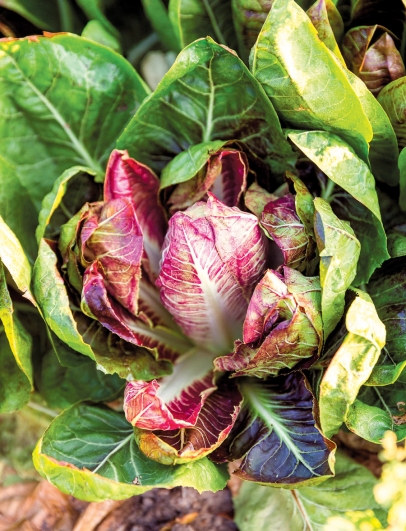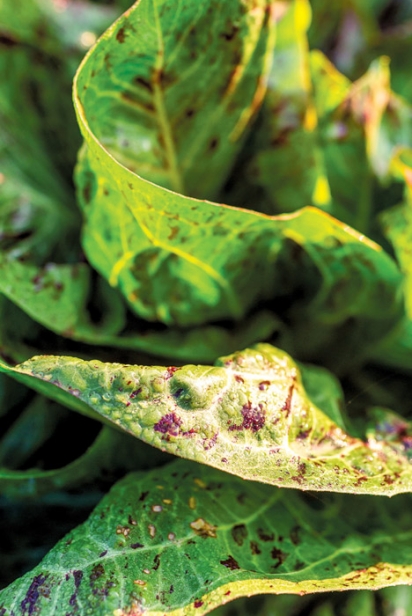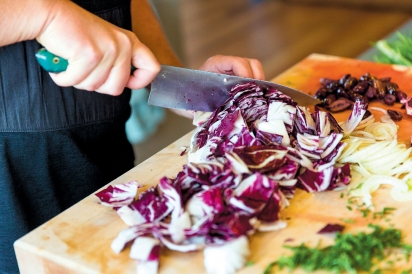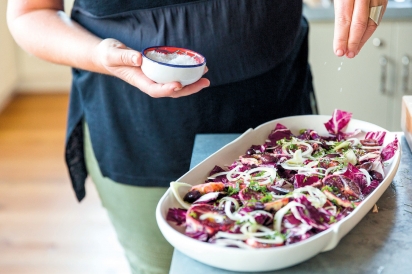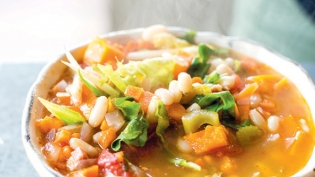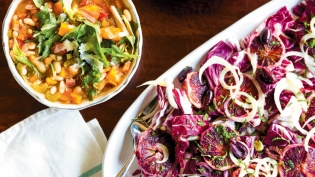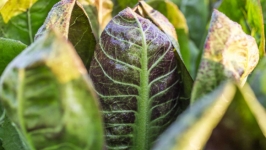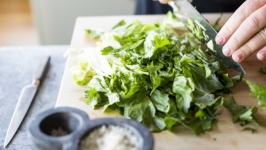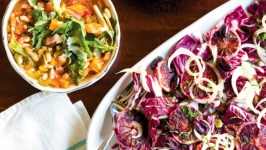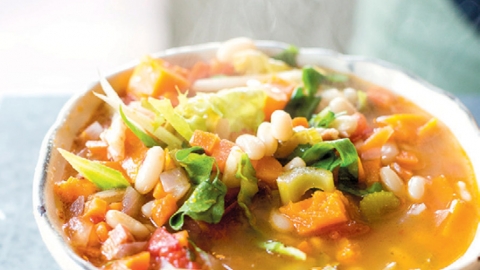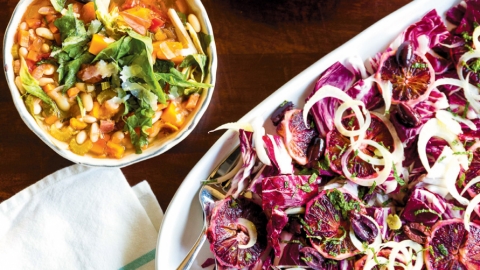Hearty, Bold and Robust
THE BITTERSWEET PERFECTION OF WINTER CHICORY
The arrival of winter also means the arrival of locally grown chicories at our farmers’ markets and grocers.
Named by Bon Appétit magazine last August as 2017 “Vegetable of the Year” (this story was already in the works, mind you), chicories have come to be available year-round, but they are at their peak of flavor in winter. The hardy greens thrive during dark, cold, wet days. When temperatures drop, these close-to-wild flora push their inner leaves tightly together, protecting themselves from the cold. The result is a core that is sweeter, less bitter and more tender than the rest of the plant—and the rest of the year.
Chicories—which include three kinds of radicchios (Chioggia, Castelfranco and Treviso), escarole, curly endive and frisée—are members of the lettuce family. The heartier and more assertive side of the family. They can be rambunctious, but are tameable, and easily transformed into hearty salads, robust soups and braises and satisfying grain dishes that are perfect for the colder months.
The bittersweet leaves hold their own next to other bold winter flavors like citrus, roasted wild mushrooms and Parmesan and, ironically, the bitterness helps to brighten and balance the other flavors.
Their hardiness also means that chicories may be cooked, as well as eaten raw. Many of their fellow lettuces would not survive the heat. Braise the outer leaves in a hearty soup or stew. Sauté them in olive oil, anchovies and garlic, and serve with shaved Parmesan for a tasty side green or pasta dish. Lightly grill them to impart a smoky char to your dish. The more tender, sweet and less bitter inner leaves are perfect to simply tear or shave into a salad.
Chicories require bold cohorts. The best flavor and texture companions are salty, sour, sweet, crunchy, garlicky and peppery:
Salty: Salty additions like Parmesan, anchovies and cured meats give these greens a fuller flavor and soften the bitterness. Salt-tasting receptors on our tongues sit closest to the bitter-tasting ones.
Sour: Pair with winter citrus like blood oranges and grapefruit or bright vinegars like white balsamic or citrus Champagne. The brightness and acidity strike a balancing contrast.
Crunchy: The heartiness of chicories pairs well with walnuts, shaved fennel and cauliflower, and apples and pears. While lesser lettuces get drowned out by crunchy bits, chicories can handle the density.
Garlicky: The potent flavor of chicory mingles well with garlic, whether it’s cooked or raw, or a combination of the two. Add roasted or raw garlic to your sautéed and braised chicory and raw salads. The punch of garlic seems to nullify some of the bitterness.
Peppery: Peppery components take the edge off the bitter. It’s like a sleight of hand on the tongue. Black pepper, arugula, green or red onions tickle out the bitter.
Sweet: A hint of sweetness optimizes your chicory dish. Raisins, figs, dates, apples, pears, honey, maple syrup and roasted veggies—particularly winter squash and carrots—are great balancing agents.
HOW TO CHOOSE CHICORY
Know where it comes from! Much of the chicory you may find on grocery shelves comes from out of our area, places where warmer growing conditions are less than ideal. Cold and damp climates produce chicory with better flavor and less bitterness.
Choose heads that are firm and heavy, with a tight center. Leaves should be crisp with little or no browning.
For loose-headed chicories like escarole and frisée, look for a good blanch on the inside leaves, with colors changing from the dark outer leaves to the lighter inner leaves.
On the balling varietals, such as radicchios, choose a solid ball that is not too big but has a significant weight. Heaviness is a sign of lots of layers inside. The color of the stems should contrast vibrantly with the colored leaves.
Typically, paler leaves and whiter stems mean a less bitter, sweeter chicory. Stems are usually sweeter than the leaves. The contrasts between the greens and stems play well together, so don’t be afraid to intermingle parts and varieties of chicories.
WASHING AND STORING CHICORIES
Chicories grow in sandy soil. The inner sections of the heads, where the leaves meet the core, can hold sand, so you may need to clean each leaf individually. They can stand up to running water, so dive in.
Chicories will keep for several weeks in your refrigerator, stored in plastic or glass.


